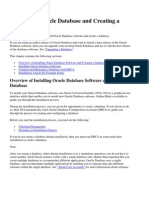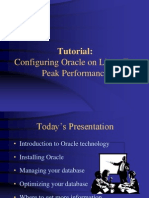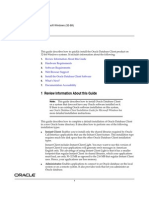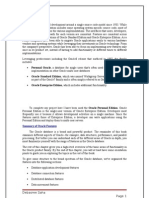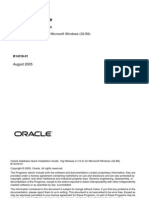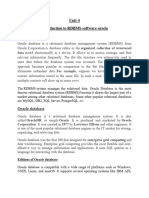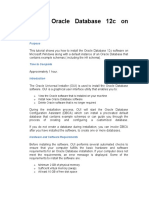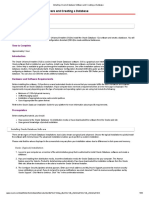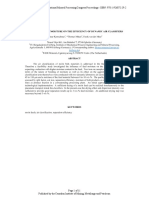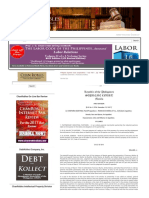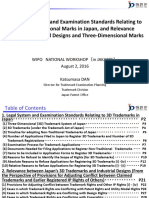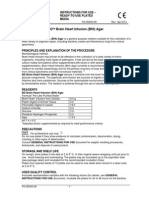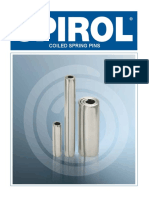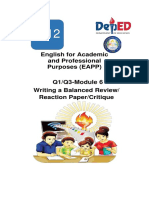Oracle® Database
Database Examples Installation Guide
23ai
F46837-03
July 2024
Examples Installation Guide
This document describes how to install and configure the products available with
Oracle Database Examples.
• Products Available with Oracle Database Examples
• Preinstallation Considerations
• Accessing the Installation Software
• About Installing Oracle Database Examples
• Documentation Accessibility
• Diversity and Inclusion
• Conventions
• Set Up Java Access Bridge to Implement Java Accessibility
Products Available with Oracle Database Examples
These sections describe the products that are installed.
You must install the following products in an existing Oracle Database 23ai Oracle
home:
• Oracle Database Examples
• Oracle Text Knowledge Base
Oracle Database Examples
Oracle Database Examples include a variety of examples and product demonstrations
that you can use to learn about the products, options, and features of Oracle
Database.
Many of these examples are designed to work with the sample schemas, which you
can install in any Oracle Database. Many documents in the Oracle Documentation
Library use the example programs and scripts provided with the Oracle Database
Examples.
1
�This section contains the following topics:
• About Oracle Data Mining Demos
• About Oracle Globalization Support Demos
• About Oracle Precompiler Demos
• About Oracle Spatial and Graph Demos
• About Oracle Internet Directory Client Demos
• About Oracle XML Demos
• About Oracle Call Interface Demos
• About Oracle C++ Call Interface Demos
• About Oracle ODBC Companion
About Oracle Data Mining Demos
Oracle Data Mining Demos include Data Mining sample programs that can help you in
learning about Oracle Data Mining APIs.
The Data Mining sample programs illustrate typical approaches to data preparation,
algorithm selection, algorithm tuning, testing, and scoring. Each program creates a
mining model in the database. All the programs include extensive inline comments to
help you understand the code.
About Oracle Globalization Support Demos
Oracle Globalization Demos showcase the features and APIs of the Oracle
Globalization Development Kit.
Oracle Globalization Development Kit (GDK) offers a complete framework to ease the
development of globalized internet applications. The GDK Example demo illustrates
individual functionalities such as, locale-sensitive data formatting, linguistic sorting,
locale mapping, locale determination, and language detection. The Oracle Store demo
illustrates how the GDK features can be integrated to build a complete multilingual
J2EE web application that serves users with vastly different locale preferences.
About Oracle Precompiler Demos
Oracle Precompiler Demos show application programmers how to embed SQL
operations in C/C++ and COBOL code in a way that is compatible with ANSI standard.
A Pro*C program is a C program containing embedded SQL statements. Oracle
Pro*C/C++ and Pro*COBOL Demos offer extensions to support dynamic SQL
operations, which are operations that can change in real time. It is also possible to use
dynamic SQL operations through PL/SQL code (known as anonymous PL/SQL block)
with a Pro*C/C++ and Pro*COBOL application. Typical applications contain much
more static SQL than dynamic SQL. The precompiler translates each embedded SQL
statement into calls to the Precompiler run-time library (SQLLIB).
About Oracle Spatial and Graph Demos
2
�Oracle Spatial and Graph Demos provide SQL schema and functions that facilitate the
storage, retrieval, update, and query of collections of spatial features in an Oracle
database.
Oracle Spatial and Graph is an integrated set of functions and procedures that enables
spatial data to be stored, accessed, and analyzed quickly and efficiently in an Oracle
database. Spatial data represents the essential location characteristics of real or
conceptual objects as those objects relate to the real or conceptual space in which
they exist.
About Oracle Internet Directory Client Demos
Oracle Internet Directory Client Demos show application programmers how to use
LDAP C and PL/SQL APIs.
All LDAP operations based on the C API, require clients to establish an LDAP session
with the LDAP server. For LDAP operations based on the PL/SQL API, a database
session must first initialize and open an LDAP session. The DBMS_LDAP package
enables PL/SQL applications to access data located in LDAP servers. The names and
syntax of the function calls are similar to those of the C API.
About Oracle XML Demos
Oracle XML Demos showcase the features of the Oracle XML Developer's Kit (XDK),
which is a versatile set of components that enables you to build and deploy C, C++,
and Java software programs that process XML.
About Oracle Call Interface Demos
Oracle Call Interface (OCI) demos include sample C programs to use the OCI APIs.
These programs provide examples of the data types, calling conventions, syntax, and
semantics of C.
About Oracle C++ Call Interface Demos
Oracle C++ Call Interface (OCCI) demos provide database access APIs for
applications written in C++. The control classes enable the applications to connect to
the database and create resources like statements and resultsets. The data classes
contain various types of data. The object classes and methods provide a navigational
interface to access and manipulate objects. The Object Type Translator (OTT) can be
used to generate the C++ class headers for the data types defined in Oracle database.
The installed demos illustrate the use of classes and methods for OTT and OCCI.
About Oracle ODBC Companion
Oracle ODBC Driver demos provide basic structure of an ODBC application which can
be extended to make a full-fledged ODBC application.
3
�ODBC being a standard, plenty of sample applications may be found in books which
discuss the concept of ODBC driver. For Oracle ODBC Driver specific options, see
Help while setting up Data Source Name on Windows.
Oracle Text Knowledge Base
Oracle Database Examples install two Oracle Text knowledge bases, English and
French. You can extend the supplied knowledge bases depending on your
requirements. Alternatively, you can create your own knowledge bases, in languages
other than English and French.
Preinstallation Considerations
The requirements for installing Oracle Database Examples are as follows:
• Free Disk Space
• Required Products
Free Disk Space
Verify that the file system that contains the Oracle home directory has at least:
• 800 MB of free disk space on UNIX systems.
• 5.43 GB of free disk space on Windows systems.
The following topics contain details about determining free disk space on UNIX and
Windows platforms:
• Determining Free Disk Space on UNIX Platforms
• Determining Free Disk Space on Windows Systems
Determining Free Disk Space on UNIX Platforms
Explains how to check free disk space on UNIX platforms.
Use the following command to check that the Oracle home directory has enough
space:
• df —k oracle_home_path
where oracle_home_path is the path to the Oracle home directory.
Determining Free Disk Space on Windows Systems
Explains how to determine free disk space on Windows systems.
Perform the following steps to check that the Oracle home directory has enough
space:
1. Double-click My Computer.
2. Right-click the drive where the Oracle software is to be installed.
4
�3. Select Properties.
Required Products
Explains the products that are required to use Oracle Database Examples.
Before you can use the Oracle Database Examples, you must install the sample
schemas in an Oracle Database. When you install Oracle Database, or use Database
Configuration Assistant to create a database, you can choose to include the sample
schemas. You can also manually install the sample schemas in an existing database.
Note:
Starting with Oracle Database 21c, all sample schemas are distributed on
GitHub:
Oracle Database Sample Schemas
Identifying the Oracle Home Directory
Explains how to identify the Oracle home directory used by Oracle Database
installation.
Before you extract products from Oracle Database Examples, you must ensure that
your system has access to an Oracle Database 23ai Oracle home. If required, you
must first install or upgrade to this release of Oracle Database.
Identify the Oracle home directory used by the Oracle Database installation.
On UNIX platforms, the oratab file is located in the /etc directory or in the /var/opt/
oracle directory. Use the more command to check the contents of the oratab file. For
example:
# more /etc/oratab
On Windows platforms:
1. From the Start menu, choose Programs, then Oracle - HOME_NAME, then
Oracle Installation Products, then Universal Installer.
2. When the Welcome screen appears, click Installed Products.
The Inventory screen appears, listing all of the Oracle homes on the system and
the products installed in each Oracle home.
3. On the Inventory screen, expand each Oracle home and locate Oracle Database
23ai.
4. Click Close and then Cancel to exit Oracle Universal Installer.
Downloading Oracle Database Examples
5
�You must download and extract the Oracle Database Examples zip file in the existing
23ai Oracle home to view the product demonstrations.
1. Go to the Oracle Database 23ai download page on Oracle Technology Network:
https://www.oracle.com/database/technologies/oracle-database-software-
downloads.html
2. Select the See All link, and then select the Oracle Database Examples zip file
under the heading Oracle Database 23ai Examples.
3. Download the Oracle Database Examples zip file to a temporary location like /tmp
directory or folder.
About Installing Oracle Database Examples
Oracle Database Examples installs the product demonstrations in the Oracle home
directory and the SQL scripts for the sample schemas in the $ORACLE_HOME/demo/
schema directory. To use these product demonstrations, you must install the sample
schemas in the database. If the sample schemas are not included during an Oracle
database installation or during database creation using Database Configuration
Assistant, then you can manually install them by running the SQL scripts.
Use one of the following methods to install Oracle Database Examples:
• Extracting Oracle Database Examples
• About demo Directories in Read-Only Oracle Homes
Extracting Oracle Database Examples
You must extract the Oracle Database Examples zip file in the existing Oracle
Database 23ai Oracle home.
Perform the following steps to extract Oracle Database Examples:
1. Log in to the computer where Oracle Database 23ai is installed.
On UNIX platforms, log in as the Oracle software owner user (oracle).
On Windows platforms, log in as an Administrator or as a member of the
Administrators group to the computer on which you want to install Oracle
components. If you are installing on a Primary Domain Controller (PDC) or a
Backup Domain Controller (BDC), log on as a member of the Domain
Administrators group.
2. Verify that the Oracle Database that you plan to use is accessible.
Refer to “Accessing the Installation Software” for details.
3. Navigate to the directory where you downloaded the Oracle Database Examples
zip file. See, Downloading Oracle Database Examples.
4. Extract the contents of the zip file to the existing Oracle Database 23ai Oracle
home.
6
�5. The Oracle Database Examples examples and product demonstrations are now
available in the Oracle home.
About demo Directories in Read-Only Oracle Homes
With Oracle Database 23ai, you can configure an Oracle home in read-only mode after
you have performed a software-only Oracle Database installation.
If you have configured a read-only Oracle home, then you must copy some demo
directories from ORACLE_HOME to ORACLE_BASE_HOME.
For more information, see Enabling a Read-Only Oracle Home and Copying demo
Directories to Oracle Base Home.
Documentation Accessibility
For information about Oracle's commitment to accessibility, visit the Oracle
Accessibility Program website at http://www.oracle.com/pls/topic/lookup?
ctx=acc&id=docacc.
Access to Oracle Support
Oracle customer access to and use of Oracle support services will be pursuant to the
terms and conditions specified in their Oracle order for the applicable services.
Diversity and Inclusion
Oracle is fully committed to diversity and inclusion. Oracle respects and values having
a diverse workforce that increases thought leadership and innovation. As part of our
initiative to build a more inclusive culture that positively impacts our employees,
customers, and partners, we are working to remove insensitive terms from our
products and documentation. We are also mindful of the necessity to maintain
compatibility with our customers' existing technologies and the need to ensure
continuity of service as Oracle's offerings and industry standards evolve. Because of
these technical constraints, our effort to remove insensitive terms is ongoing and will
take time and external cooperation.
Conventions
The following text conventions are used in this document:
Convention Meaning
boldface Boldface type indicates graphical user interface elements associated
with an action, or terms defined in text or the glossary.
italic Italic type indicates book titles, emphasis, or placeholder variables for
which you supply particular values.
7
� Convention Meaning
monospace Monospace type indicates commands within a paragraph, URLs, code
in examples, text that appears on the screen, or text that you enter.
Set Up Java Access Bridge to Implement Java
Accessibility
Install Java Access Bridge so that assistive technologies on Microsoft Windows
systems can use the Java Accessibility API.
Java Access Bridge is a technology that enables Java applications and applets that
implement the Java Accessibility API to be visible to assistive technologies on
Microsoft Windows systems.
Refer to Java Platform, Standard Edition Accessibility Guide for information about the
minimum supported versions of assistive technologies required to use Java Access
Bridge. Also refer to this guide to obtain installation and testing instructions, and
instructions for how to use Java Access Bridge.
Oracle Database Database Examples Installation Guide , 23ai
F46837-03
Copyright © 2011, 2024, Oracle and/or its affiliates. All rights reserved.
This software and related documentation are provided under a license agreement containing restrictions on use and disclosure and are protected by intellectual property laws.
Except as expressly permitted in your license agreement or allowed by law, you may not use, copy, reproduce, translate, broadcast, modify, license, transmit, distribute, exhibit,
perform, publish, or display any part, in any form, or by any means. Reverse engineering, disassembly, or decompilation of this software, unless required by law for
interoperability, is prohibited.
The information contained herein is subject to change without notice and is not warranted to be error-free. If you find any errors, please report them to us in writing.
If this is software, software documentation, data (as defined in the Federal Acquisition Regulation), or related documentation that is delivered to the U.S. Government or anyone
licensing it on behalf of the U.S. Government, then the following notice is applicable:
U.S. GOVERNMENT END USERS: Oracle programs (including any operating system, integrated software, any programs embedded, installed, or activated on delivered
hardware, and modifications of such programs) and Oracle computer documentation or other Oracle data delivered to or accessed by U.S. Government end users are
"commercial computer software," "commercial computer software documentation," or "limited rights data" pursuant to the applicable Federal Acquisition Regulation and agency-
specific supplemental regulations. As such, the use, reproduction, duplication, release, display, disclosure, modification, preparation of derivative works, and/or adaptation of i)
Oracle programs (including any operating system, integrated software, any programs embedded, installed, or activated on delivered hardware, and modifications of such
programs), ii) Oracle computer documentation and/or iii) other Oracle data, is subject to the rights and limitations specified in the license contained in the applicable contract.
The terms governing the U.S. Government's use of Oracle cloud services are defined by the applicable contract for such services. No other rights are granted to the U.S.
Government.
This software or hardware is developed for general use in a variety of information management applications. It is not developed or intended for use in any inherently dangerous
applications, including applications that may create a risk of personal injury. If you use this software or hardware in dangerous applications, then you shall be responsible to take
all appropriate fail-safe, backup, redundancy, and other measures to ensure its safe use. Oracle Corporation and its affiliates disclaim any liability for any damages caused by
use of this software or hardware in dangerous applications.
Oracle®, Java, MySQL, and NetSuite are registered trademarks of Oracle and/or its affiliates. Other names may be trademarks of their respective owners.
Intel and Intel Inside are trademarks or registered trademarks of Intel Corporation. All SPARC trademarks are used under license and are trademarks or registered trademarks
of SPARC International, Inc. AMD, Epyc, and the AMD logo are trademarks or registered trademarks of Advanced Micro Devices. UNIX is a registered trademark of The Open
Group.
This software or hardware and documentation may provide access to or information about content, products, and services from third parties. Oracle Corporation and its affiliates
are not responsible for and expressly disclaim all warranties of any kind with respect to third-party content, products, and services unless otherwise set forth in an applicable
agreement between you and Oracle. Oracle Corporation and its affiliates will not be responsible for any loss, costs, or damages incurred due to your access to or use of third-
party content, products, or services, except as set forth in an applicable agreement between you and Oracle.
